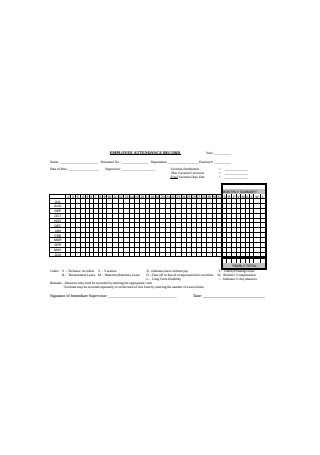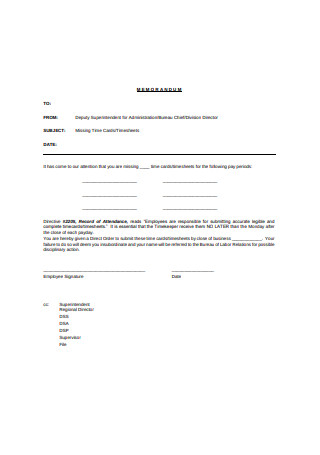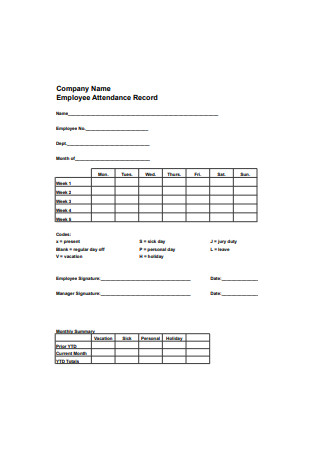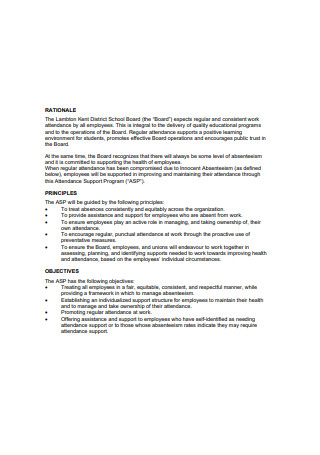38+ Sample Employee Attendance Records
-

Sample Employee Attendance Record
-

Employee Working Attendance Record
-

Pacific Employers Attendance Record
-

Employee Attendance Record Memorandum
-

Employee Time and Attendance Record
-

Employee Attendance Record Form
-

Company Employee Attendance Record
-

Faculty and Professional Employee Attendance Record
-

Administrative Employee Attendance Record
-

Employee Record of Attendance
-

Employee Attendance Record Summary
-

Household Employee Attendance Record
-

Employee Calendar Attendance Record
-

Sample Employee Attendance Record
-

Employee Attendance Record Example
-

Daily Employee Attendance Record
-

Employee Training Attendance Record
-

Employee Safety Training Attendance Record
-

Employee Training Attendance Record Example
-

Employee Attendance Management Program Report
-

Employee Attendance Record Policy Statement
-

Monthly Employee Attendance Record
-

Staff Attendance Record
-

Non Teaching Staff Employee Attendance Record
-

Employee Daily Attendance Record
-

Employee Attendance Management Record
-

Employee Yearly Attendance Record
-

Office Employee Attendance Record
-

Employee Attendance Record Sample
-

Employee Attendance Level Record
-

Employee Attendance Record Procedure
-

Employee Attendance Record Format
-

Simple Employee Attendance Record
-

School Employee Attendance Record
-

Employee Attendance Recording Example
-

Basic Employee Attendance Record
-

Employee Attendance Record using Fingerprint
-

Sample Employee Time and Attendance Record
-

Procedures for Employee Attendance and Leave Record
What Is an Employee Attendance Record?
An employee attendance record is a visual tracker that enables you to monitor the attendance of each of your employees. The presence, absence, and authorized leaves of employees documented in the record will help employers calculate the salary of an individual accordingly. This can also come in handy as you conduct meetings and seminars that require the complete attendance of the members of your staff. The record may come in the form of a printed or digital sheet which you can then encode into the company database for security. Documents like these should only be accessible to authorized individuals to avoid the corruption of original data. Monitoring planned and unplanned absences should help you determine whether certain instances conform to your company’s attendance policies. Even if they do, you still need to be mindful of their effects on your everyday operations to find out whether enforcing a more reasonable attendance plan would be necessary.

The Benefits of an Employee Attendance Record
Tracking employee attendance is crucial for every company. Although not always understood, documenting the attendance of employees will not only strengthen the workforce but also ensure that employee records remain accurate and reliable for making business-related decisions. When managed correctly, it can be a major asset for any workforce.
One reason why employers monitor attendance is to uncover potential issues to address. For instance, employees with consistent accounts of tardiness exhibit clear signs of poor conduct. This is not something the management should take lightly, especially if other employees begin mirroring this behavior. Other times, low attendance rates can also tell you a thing or two about the working environment people face. Fit for Work, a government-funded initiative that supports and helps workers with health conditions and sickness absence, reports that 40% of the time that an average employee takes off each year is due to a mental health-related issue. This shows that some people don’t file for leaves due to matters that require their attention, but because they simply don’t feel like it.
Another benefit of an employee attendance record centers on the company’s payroll system. You want to make sure that workers get paid in full to compensate for their hard work and effort in meeting business objectives. Seeing the patterns and frequency in employee overtimes will also force you to consider redistributing workloads between staff members to improve individual productivity and team performance. This will boost their morale and give them a good reason to come to work every day.
How to Make an Employee Attendance Record
Reduced attendance rates have many implications. Employees who are consistently late or absent despite being tenured members of the organization may have an underlying reason for their behavior. According to Gallup, disengaged workers cost the U.S. $450 to $550 billion per year in productivity loss. While problems at home could be a factor, issues within the company are very much plausible. Keeping a close eye on your employees’ attendance patterns is sure to benefit your current and future business operations in a variety of ways.
Listed below are the steps to help you create an employee attendance record that works.
Step 1: Look for a Template
You’ll likely be using the same format for your attendance record spreadsheet for the next couple of years. With that said, it only makes sense to use a template to spare yourself from the hassle of starting from scratch. Simply look for an HR template that suits your specific function. It is always advisable to modify the contents of the template to meet your company requirements, as most templates cater to a more general purpose. You may refer to your existing HR documents, such as your HR forms and reports, and see how you can keep these records as uniformed as possible. Keeping your internal documents consistent with one another is sure to make it easier to process.
Step 2: Use Proper Labeling
Don’t make the record challenging to read. For the sake of every single person in your team, label parts of your attendance sheet appropriately. This constitutes to the headings and subheadings of the form or sheet. Those responsible for processing these records won’t be a part of the company forever. If this employee advances in position or decides to leave the company, the successor for the job should be able to take over matters with ease. Hence, avoid using complicated terms for your labels. Observe proper alignment when inputting data into the record as well. Be sure to maintain an organized structure throughout your practice, even when applying changes to the data already reported.
Step 3: Make Room for Adjustments
It’s common for someone to work beyond their regular working hours as long as they are authorized by their respective superiors to extend their time at the office. Allowing employees to leave work at an earlier time is also possible if they have a valid reason to do so. Undertimes and overtimes are quite prevalent in most company settings, which is why your attendance record should cater to these as well. Your HR and accounting staff must be aware of these exceptional cases by indicating them in the sheet. You can assign abbreviations or use colors to specify any adjustments. The record must be as flexible as possible to ensure that all incidents are taken into account.
Step 4: Enable Comments and Other Notes
It’s easy to attach notes and comments to your record when you utilize a digital file for your timekeeping sheet. But if you decide to secure a handwritten copy of the document to leave a paper trail as a backup, the best way to keep your record clean and in order is to designate a separate section for any comments or notes that the user would want to add. For example, you can indicate that the employee is present for the day but is out of the office to do some fieldwork. Employees who participate in seminars, training programs, conferences, and other essential meetings should still be paid for their time despite not having an actual output for their productivity. Note that exemptions are only applicable to employees with individual assignments.
Step 5: Keep it Up to Date
Records must be updated daily. This will make it easier to monitor the attendance of your workforce to recognize tardiness, absences, and sick/vacation leaves by the end of each working period. Don’t hesitate to remind employees to update their sheets as well to prevent discrepancies.
The Dos and Don’ts of an Employee Attendance Record
It is the obligation of an employer to keep accurate attendance records of non-exempt employees. This seemingly simple process may seem easy at first until you realize how prominent it is for employees to travel for business, participate in training programs, work overtime, and engage in out-of-office activities despite having the day off. All these must be captured clearly in one document. To meet the specific needs of your organization, consider the following dos and don’ts.
Dos
1. Do utilize an accurate timekeeping system.
Time clocks, time sheets, and ID scanners are some common examples of timekeeping methods in today’s market. These tools make it convenient for you to count the amount of time rendered by an employee at the end of each working day. Following a standard system ensures that data remains consistent even when shared across different platforms and departments. Provided that it is complete and accurate, a timekeeping system should make it easy for you to monitor and compensate employees for their contributions to the company.
2. Do record training and travel time.
Under the Family and Medical Leave Act (FMLA) and many state laws, employers must reimburse employees for the time spent during training seminars and business travels. This is especially important when you task a person to work on dates that do not fall under their regular working days. Terms and conditions for these arrangements may reflect in the employment contract or employee handbook to keep everyone in the company informed. Be sure to instruct employees to record their time for compensation reasons.
3. Do allow employees to verify their attendance.
In some company settings, managers require employees to submit an end-of-day report containing their attendance and productivity details for the day. It’s one way to track workforce activities by putting everything in one place. If an employee’s personal record fails to match with yours, the contrariety must be investigated by the management. If they happen to forget the correct clock-in and clock-out details, you can offer to assist them using the records from your report. Employees who have permission to work overtime must also note the extra time that they worked in the sheet.
4. Do be transparent.
At the end of each pay period, you can have your employees confirm their time records. This is an opportunity for the employee to correct any discrepancies in the report that they have enough evidence to prove wrong. Witness accounts may even help support one’s claims, especially if it comes from the employee’s direct supervisor or team leader. Acknowledge the fact that mistakes are often inevitable, and system errors are bound to cause inconsistencies in your HR documents. By remaining transparent with employees, you can reduce the risk of making payroll mistakes during every cut-off date.
5. Do eliminate the risk of unauthorized absences and false records.
Have you ever heard about the “buddy punching” system? This unethical practice is pretty common in workplaces that employ loose attendance policies and inferior recording methods. Without proper monitoring, employees can easily cheat the system by allowing a coworker to do the punching on their behalf. This makes it impossible for an employer to penalize employees for their tardiness. Thus, it’s essential to establish a stable timekeeping system to ensure your attendance records are as accurate as possible.
6. Do adopt and distribute a written policy for employees to take responsibility for recording their attendance.
Establishing accountability among company employees is crucial in ensuring that your records remain accurate. The times an individual arrives at and leaves work should be reflected in the attendance sheet in correct detail. If you have an automatized system to do the work for you, the least you could do is make the data collected available for employees to review. Employees assigned to special projects must also have the initiative to note these adjustments in their timekeeping records. Direct supervisors or department managers can verify this information by signing the document or writing a note to the HR manager.
Don’ts
1. Don’t assume that all your employees are accurately and honestly recording their attendance.
The truth is, every workforce has at least one employee who lies in their attendance record to escape the consequences of their actions. While time rounding is sometimes excused by company policies, those who abuse this privilege by making an untruthful account of their attendance are clearly committing a violation. This often happens when employers are only able to provide an attendance form for workers to sign. Although it’s impossible to avoid this from happening, the least you can do is implement strict regulations against the deed.
2. Don’t ignore issues and inconsistencies in employee attendance.
The fault may be under the hands of either party; nonetheless, it’s still something to be alarmed about. The act of falsifying attendance records should be treated seriously by employers. It’s also possible that errors in the system may have caused the inconsistencies, which force you to address them immediately. Speak with the employee and obtain their personal input. You need to act swiftly before one problem leads to another, making it difficult for you to acquire reliable evidence of an employee’s work hours.
3. Don’t make it hard for employees to take a leave of absence.
After working around the clock chasing clients and meeting deadlines, every employee deserves some time off from their job responsibilities. You don’t want to make it difficult for employees to request and be granted vacation leave. To allow eligible employees to take a leave of absence and avoid becoming understaffed on those days, you have to maintain a correct and up-to-date attendance record. You can easily refer to the document to determine whether to approve or deny an employee’s request for absence.
4. Don’t be too doubtful.
Dealing with the same issues regarding an individual’s attendance record can become frustrating at some point. But this shouldn’t give you a reason to lose all your trust in your employees. When people feel like you are monitoring their every move, they’ll begin to feel conscious of their actions, which may threaten their performance while on the job. Refrain from implementing policies that don’t consider an employee’s welfare in terms of tardiness, authorized and unauthorized absences, and break times. You must give the opposite party the benefit of the doubt whenever you discover inconsistencies in the system that you have yet to resolve.
5. Don’t forget to review your timekeeping procedures regularly.
A great way to prevent discrepancies is to conduct a regular review of your timekeeping procedures to find out if employees are following them. Rules exist for a reason, and if the targeted body fails to acknowledge them, your timekeeping policies are as good as nothing. Consider this as an opportunity to determine whether your procedures need revising as well. It’s always a good idea to update your business procedures from time to time to obtain favorable results.
6. Don’t lose the data.
There’s nothing more unfortunate than losing two weeks’ worth of records due to mismanagement. Accidents happen, and you won’t always have the resources to avoid them. You’ll be forced to obtain this information manually to run the payroll on time. However, doing so is far from easy without an actual document to support individual accounts. This is one of the reasons why you need a back-up plan to keep operations at bay. Uploading these files to “the cloud” or sharing this information with an authorized group of people will make it easy for you to retrieve the data following the incident. You can also secure extra copies of each attendance record just to be safe.
Optimize your management skills efficiently with the use of an employee attendance record. By doing so, you can assist employees in being more accountable for their actions and make sure they’re paid for the time they spent working. A simple tool like this can give your company the push it needs to stay on top of employee activities. It’s an effective way to boost your team’s productivity for the organization’s overall success.
